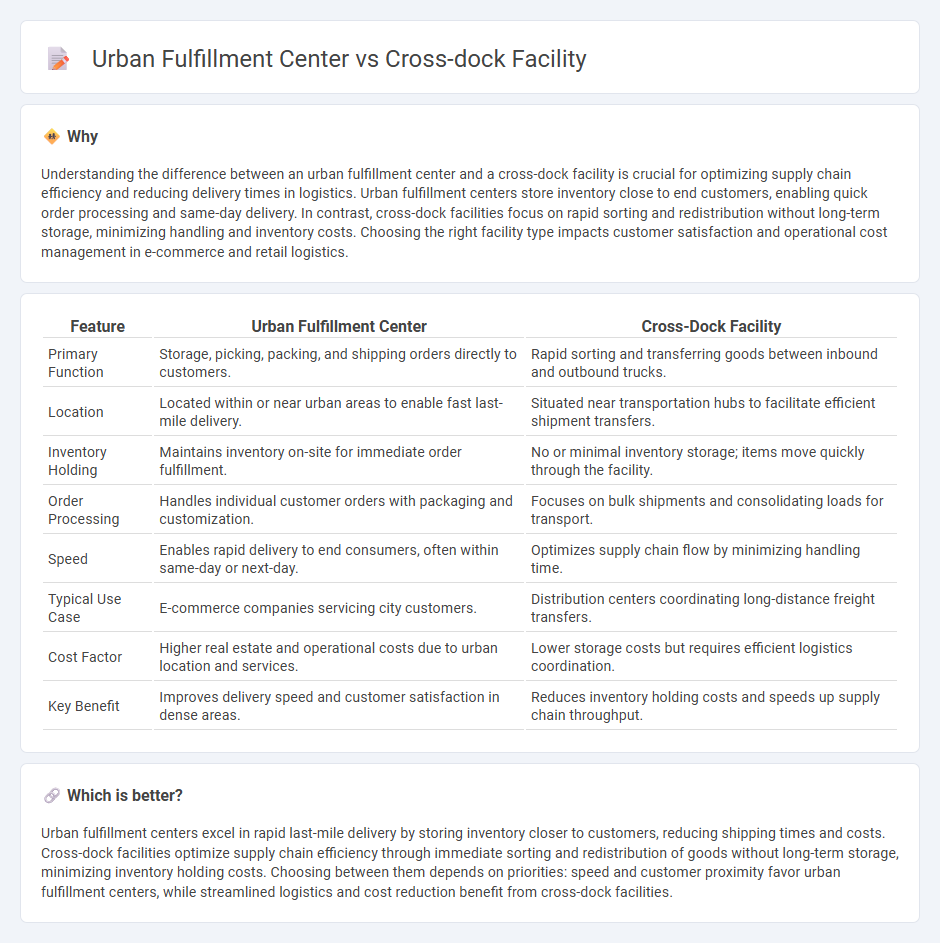
Urban fulfillment centers are strategically located near city centers to enable rapid delivery and accommodate high order volumes with efficient inventory management, while cross-dock facilities focus on minimizing storage time by directly transferring goods from inbound to outbound transportation. These facilities optimize last-mile delivery and supply chain velocity through distinct operational approaches tailored to urban demands and freight consolidation. Explore the advantages and applications of both to enhance your logistics strategy.
Why it is important
Understanding the difference between an urban fulfillment center and a cross-dock facility is crucial for optimizing supply chain efficiency and reducing delivery times in logistics. Urban fulfillment centers store inventory close to end customers, enabling quick order processing and same-day delivery. In contrast, cross-dock facilities focus on rapid sorting and redistribution without long-term storage, minimizing handling and inventory costs. Choosing the right facility type impacts customer satisfaction and operational cost management in e-commerce and retail logistics.
Comparison Table
| Feature | Urban Fulfillment Center | Cross-Dock Facility |
|---|---|---|
| Primary Function | Storage, picking, packing, and shipping orders directly to customers. | Rapid sorting and transferring goods between inbound and outbound trucks. |
| Location | Located within or near urban areas to enable fast last-mile delivery. | Situated near transportation hubs to facilitate efficient shipment transfers. |
| Inventory Holding | Maintains inventory on-site for immediate order fulfillment. | No or minimal inventory storage; items move quickly through the facility. |
| Order Processing | Handles individual customer orders with packaging and customization. | Focuses on bulk shipments and consolidating loads for transport. |
| Speed | Enables rapid delivery to end consumers, often within same-day or next-day. | Optimizes supply chain flow by minimizing handling time. |
| Typical Use Case | E-commerce companies servicing city customers. | Distribution centers coordinating long-distance freight transfers. |
| Cost Factor | Higher real estate and operational costs due to urban location and services. | Lower storage costs but requires efficient logistics coordination. |
| Key Benefit | Improves delivery speed and customer satisfaction in dense areas. | Reduces inventory holding costs and speeds up supply chain throughput. |
Which is better?
Urban fulfillment centers excel in rapid last-mile delivery by storing inventory closer to customers, reducing shipping times and costs. Cross-dock facilities optimize supply chain efficiency through immediate sorting and redistribution of goods without long-term storage, minimizing inventory holding costs. Choosing between them depends on priorities: speed and customer proximity favor urban fulfillment centers, while streamlined logistics and cost reduction benefit from cross-dock facilities.
Connection
Urban fulfillment centers and cross-dock facilities are interconnected nodes in the logistics network that streamline order processing and delivery speed. Urban fulfillment centers store inventory close to end customers, enabling rapid last-mile delivery, while cross-dock facilities facilitate the efficient sorting and redistribution of goods without long-term storage. This synergy reduces transit times and operational costs, enhancing overall supply chain responsiveness in metropolitan areas.
Key Terms
**Cross-dock facility:**
Cross-dock facilities streamline logistics by minimizing storage time, enabling rapid transfer of goods from inbound to outbound transportation, which enhances supply chain efficiency and reduces inventory holding costs. These facilities are strategically designed for fast-paced consolidation and distribution, playing a crucial role in industries like retail and manufacturing to optimize delivery speed and reduce lead times. Discover more about how cross-dock facilities revolutionize supply chain management and urban fulfillment strategies.
Transshipment
Cross-dock facilities streamline transshipment by rapidly transferring goods from inbound to outbound transportation, minimizing storage time and reducing handling costs. Urban fulfillment centers emphasize final-mile delivery, storing inventory closer to end customers to enhance speed and responsiveness in dense metropolitan areas. Explore the key differences in transshipment efficiency and operational focus between these two logistics hubs.
Flow-through
Flow-through efficiency in cross-dock facilities hinges on rapid sorting and minimal storage, enabling direct transfer from inbound to outbound shipments to reduce handling time and labor costs. Urban fulfillment centers emphasize speed and proximity to customers, integrating flow-through processes with last-mile delivery to meet growing e-commerce demands. Discover how these logistics strategies optimize supply chain performance and customer satisfaction.
Source and External Links
Understanding cross-docking: A comprehensive guide - Maersk - *Cross-docking* is a logistics process where products from suppliers or manufacturers are directly transferred to customers with minimal or no storage time, relying on efficient facility design, dock door placement, scheduling, and real-time information systems to optimize throughput and reduce operational costs.
What Is Cross-Docking? Definition, Types & Advantages - NetSuite - A *cross-dock warehouse* is a logistics facility designed for rapid transfer of goods from inbound to outbound shipments, minimizing storage time and speeding delivery by sorting and quickly dispatching goods without long-term warehousing.
Cross-docking: meaning, benefits, types, uses | Red Stag Fulfillment - Cross-docking facilities are optimized to move inbound pallets directly to outbound trucks efficiently, reducing lead times in eCommerce and retail distribution by bypassing traditional storage and order picking processes.
 dowidth.com
dowidth.com